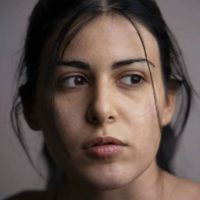Public
Discourse
Award
The Missing Daughters of the South Caucasus
published by Outriders, Poland
The original publication of the project is embedded below. Underneath, find the full text.
#1. INTRODUCTION. “My parents named my sister ‘Enough’”.
GEGHARKUNIK REGION, Armenia – The trembling hands of Lena Khachatryan, an 84-years-old woman who has worked her entire life on the farm and the house, turned the pages of an old red velvet family photo album and stopped on one: “When my mother got pregnant with the third girl, they named my sister ‘Bavakan’ (‘enough’ in Armenian),” she said.
In Armenia, families used to call their daughters “Enough” when they did not want to have more girls. In 2023 there were over 1,500 women named “Enough” in Armenia (1,563, according to the voter census). Lena’s sister already passed away.
In China, another country with a strong preference for sons, some women are changing their sexist names, such as “Yanan” (meaning “second only to men”) or “Zhaodi” (“beckon to younger brother”).
“My sister, however, was not enough, and I was born,” Lena added, smiling, resting her hands on her thick brown wool sweater in the living room of her house in Tsovazard, a village at the shores of Lake Sevan. She was the fourth daughter; the long-awaited son was born after her.
When Lena married at the age of 20, she immediately went to live at her in-laws’ house, like many Armenian women do. “I had a difficult life”, she said. “There were no blankets, and we all slept in the same room: my husband and I and his parents. The cows were in the other room”. She had a miscarriage during her first pregnancy due to the hard work she did on the farm. Her mother-in-law, a very tough woman, told her that if she didn’t bring a child, she would kick her out. Finally, she had three daughters and two sons.
Son preference is an ancient form of gender discrimination. Traditionally, it manifested itself in what is known as “son-biased fertility-stopping” behaviour, that is, families had children until the number of boys they desired was born.
However, since the 1980’s, when modern access to reproductive technologies to determine the foetus’s sex was developed, an alteration of the normal ratio between male and female births began to be observed.
A pattern indicating that some families were having selective abortions of unwanted girls appeared. This practice is known as gender-biased sex selection (GBSS) – the voluntary termination of pregnancy based on the sex of the fetus; most often when it is female. It is estimated that the number of sex-selective abortions per year increased from nearly zero in the late 1970s to 1.6 million per year in 2005-2010 globally.
Sex-selective abortions have become especially visible in some parts of East Asia, South Asia and the South Caucasus, including China, India, South Korea and Vietnam, as well as three ex-soviet countries: Armenia, Azerbaijan and Georgia.
The tiny Principality of Liechtenstein, which is one of the most restrictive European countries on the right to abortion, has also shown a high imbalance in the sex ratio at birth.
Asia, a continent of men
The natural sex ratio at birth is around 105 boys per 100 girls. In some countries, however, many more boys are born.
Why do some parts of the world have many more boys than girls than the natural birth rate?
Erasing 140 million women from the world
The term “missing women” was coined by Indian economist and Nobel laureate Amartya Sen, who observed that many more males than females were born in India. Some academics warned that the consequences of this imbalance in China or India could result in an upcoming “marriage squeeze” with heterosexual men who will not be able to find potential partners.
Since the 90s, some regions have seen up to 25 per cent more male births than female births, according to the UN Population Fund (UNPF). It is estimated that some 140 million women are missing in the world.
In Armenia, an estimated 1,400 girls are not born every year due to a rooted preference for male children.
Mariam could have been one of them.
#2. CONTEXT. Mariam could have been one of them
Mariam’s parents had two daughters, aged 11 and 12, when in 1991, in the midst of the energy crisis after the dissolution of the USSR, her mother became pregnant again. They were the so-called ‘dark years’ in Armenia, where a combination of war, lack of natural resources and a blockade by Azerbaijan had plunged the country into cold and hunger.
In the heart of the Gegharkunik region, a province of farmers and cattle breeders, people began to use firewood for cooking, candles for light and coats to keep warm at home. Marian’s parents then decided that if it was a boy, the mother would give birth; if it was another girl, she would have an abortion.
“You see, if it was a son, it would have been possible to continue with the pregnancy, but if it was a girl, we did not have enough bread or butter,” said Liana Asoyan, 45, the elder sister, at the nursery school that she runs next to the family home in Gavar town. Immersed in the first Nagorno-Karabakh War (1988-1994), she explained, families preferred to have male children with the idea that they would protect the country.
Thirty years have passed, and one of the women present in the conversation is the baby of that story – it was a girl. Her name is Mariam. Her mother, while pregnant with her, went to the hospital several times to confirm the fetal gender and even visited a fortune-teller, “but she still had hope that it would be a boy because people told her that the belly looked different than in previous pregnancies”, Liana said.
In the fifth month, as there was no doubt, they decided to terminate the pregnancy, but one of the sisters convinced the parents: “Would you have done the same to me because I am a girl?” And Mariam was born.
“The most important thing is that I’m here now”, laughed Mariam Asoyan, 30, dressed in black, as she breastfed her baby daughter. Her mother watered the tulips in the garden. Marian had never talked to her parents about it, “only my sisters teased me when I was a child,” she said. “We told her she is here thanks to us,” joked Liana.
The case of the Southern Caucasus
Armenia has experienced an alteration from the natural sex ratio at birth since the early 90’s, after the dissolution of the Soviet Union. While the biologically normal ratio at birth ranges from 102 to 106 boys per 100 girls, in Armenia, ratios as high as 120 boys per 100 girls were recorded in the early 2000s, according to the National Statistical Service (NSS); they even reached 124 male per 100 females in Gegharkunik region, one of the places where more boys are born in the world.
The root causes of this phenomenon in China are a consequence of the one-child policy combined with son preference. In India, it is related to patriarchal perceptions that consider women less valuable than men, who maintain the family legacy by carrying the family name and performing funeral rites for their parents; but why in the South Caucasus?
There are similarities between the South Caucasus and some countries in Asia, Nora Dudwick, Senior Social Scientist at World Bank, explained in the report “Missing Women” in the South Caucasus (2015). “Skewed sex ratios are associated with patriarchal social structures and expectations that sons will support parents in their old age, while daughters will leave their parents at marriage to invest their labour in their husband’s family,” she said.
Gegharkunik, one of the regions where the most boys are born in the world
The news caught them by surprise in Martuni, a town of some 12,000 people, from which men spend long periods far from home working as seasonal labourers in construction in Russia and women stay at home with their parents in-laws.
“There was a research, and it turned out that in terms of sex-selective abortions, our region, Gegharkunik, was in the first place, above China,” said Anahit Gevorgyan, head of Martuni Women’s Community Council, an NGO addressing socio-economic problems through the direct involvement of their residents. With 124 boys born per 100 girls born, they had a problem.
Gevorgyan is a tall woman who has been advising the citizens of Martuni for decades. In the past, she held a high position in the administration and people used to ask her for help. That’s why in 2000, she launched this community council, “I couldn’t do everything by myself.” They started working with women, she explained, and now they work on community development.
At the council, a group of women were discussing transportation problems, cases of domestic abuse and what they call “the demographic issue”, referring to the fact that more boys are born than girls in the town. Anna Hokhikyan, a first-grade teacher with big eyes and short brunette hair, said that her students are 20 boys and five girls, and there are similar ratios in other classrooms.
“Parents of girls are happy and love them. The problem starts when society asks them: why don’t you have a boy? Who will keep the house?” Gevorgyam said.
In addition, “the decision makers are the people who have the money, and many women don’t work in this region”, said Manan Mkhitaryanm, Project Coordinator. “The corruption level is also high”, she added. “So if there is an informal payment in the hospital, it is difficult for women to make their own decisions, firstly because it is not their money, and secondly because there are some shameful things that women should not do, like refusing to pay to the relative who works in the hospital”, she said.
Between 2015 and 2017, Martuni Women’s Community Council, in partnership with the International Center for Human Development, Armavir Development Centre and Save the Children, implemented a two-year programme on combating gender-biased sex selection in Armenia, funded by the European Union. It included working with community leaders and local authorities, as well as researching, training and awareness-raising campaigns.
Among the activities, they produced several commercials for television and materials for hospitals and schools. “Let our sisters be born,” said a boy with a balloon in one of them. The aim was to get at least a 15% positive change in attitude and a 10% reduction in the number of sex-selective abortions. Gevorgyan admitted there was a positive change, but the challenge is still great.
#3. CAUSES. “In our family tree, girls are just leaves.”
When a study confirmed a trend of sex-selective abortion in Armenia, the first step was to understand why and who and when decided it.
In the leaving room of a two-story house where a family raises chickens, sheep, and cows, there was a black and white wedding portrait on a tablecloth with drawings of pomegranates that remembered the day that Gohar Grigoryan, 53, went to live at her in-laws’ home and kept silent.
Gohar, 53, was not allowed to speak directly to her father-in-law. Today she lives with two sons and their wives and her three grandchildren.
Gohar covered her mouth with one hand, in which a golden ring shined, and her eyes watered, “I lived like this for four years, quiet.” She was not allowed to speak directly to her father-in-law, she explained, so if she wanted to visit her parents, she had to ask her mother-in-law for permission, and she would ask her husband, “and sometimes he said ‘no”.
Gohar is now a mother-in-law and lives with two sons and their wives and her three grandchildren. In the kitchen, the young daughters-in-law were cooking trout and bread with cheese and tarragon. The children ran around.
Similarly, in other countries with a preference for sons, such as India, “in the absence of strong social security measures and lack of preference for old-age homes (…), the dependency on sons will continue”, explained the report ‘Patrilocality and Child Sex Ratios in India’.
Things have changed since her youth, Gohar admitted, “but families still prefer boys.” She recalled the case of a young woman from her village who had two daughters and became pregnant with a boy. It was a risky pregnancy, and the doctors said if she did not terminate it, the mother could die. “But the family did not agree because it was a boy”, Gohar said. The woman died after giving birth; the boy was born.
In the report ‘Giving women a voice’ (2014), Jilozian, director of development at the Women’s Support Center, identified three main factors why sex-selective abortions increased in Armenia after its independence in the 90’s: in a society with a strong preference for sons, she explained, more accessible technology has allowed identifying foetal sex in early stage and a drop in the birth rate since the collapse of the Soviet Union, has meant that having fewer children is less chance of having a boy.
The root of the problem, however, “is the fact that they prefer sons”, said Anna Hovhannisyan, Advocacy and Policy Development team manager at the Women’s Resource Center of Armenia. “This is why we use the term ‘son preference’ instead of ‘sex-selective abortion’ to show where the problem is coming from”, she clarified. And “the reason behind son preference is very simple: it’s patriarchy, and more specifically, gender inequality,” she explained. “In postwar and militarised societies like Armenia, there is also a prioritisation for males as future protectors of our land,” she added, “this narrative is also making inferences, but globally, the reason it’s patriarchy.”
There is a range of activities that Armenian society attributes to men, including the continuation of the family clan, the care of parents, the labour in agricultural regions and the defence of the country.
Armenia is a patrilineal society in which it is considered that only sons ensure the continuation of the family lineage.
Armenian families are also patrilocal, meaning women usually move to the house of their husband’s parents at the time of marriage. As daughters leave the house, some families prefer to have sons to have someone to take care of them when they are old. Studies suggest that populations in areas devoted to intensive agriculture have stronger patrilocal norms.
“In many Armenian houses, there is a family tree. In our tree, my branch has my name and a leaf at the end, but new branches sprouted from my brother’s branch,” said Arevik, 27, a mother of two-year-old twin daughters. Armenians consider that only sons ensure the continuation of their family lineage.
On a spring afternoon, Arevik, 27, in jeans and sneakers, walked her two-year-old twin daughters, Sofi and Lia, in a stroller across a park on the outskirts of Yerevan. Older people on benches rested in the shade, children rode bikes, and a seamstress sewed in a booth. A man lighted a cigarette and asked, gazing over the stroller:
–Are they boys or girls?
–Girls –Arevik replied.
–Don’t worry, the important thing is that they are healthy.
“Suddenly, everyone decided that I should be worried because both are girls,” lamented Arevik, who said that this kind of situation happens “several times, every single day, with strangers.”
“I feel a lot of pressure because I know my husband’s family expects me to have a boy. For Armenian society, girls are not enough”, continued Arevik. She explained that the doctors informed her about the sex of the twins in the fifth month of pregnancy, “and a relative suggested that they had told her so late so I wouldn’t have an abortion.”
“When you have a boyfriend, they pressure you until you marry. When you marry, they pressure you until you have children. When you have children, they pressure you until you have a boy”, she added.
“Even before abortions, there are all kinds of rituals and people making money for families to have sons,” said Sevan Petrosyan, who managed ‘Caring for Equality’ (2015-2019), a four-year project on sex-selection at World Vision Armenia. “Magic, charms and fortune-telling were utilised not only to predict the sex of the expected child, but also to ‘order’ boys,” explained researcher Tsaturyan Ruzanna in the report ‘How to have a boy’.
#4. THE DECISION MAKERS. Silent violence.
Tatevik Aghabekyan, president of the Sexual Assault Crisis Center in Yerevan
On a Sunday at noon in a room full of toys in northern Yerevan, Tatevik Aghabekyan, president of the Sexual Assault Crisis Center, played with her three daughters, Marie, 11, Nare, 7 and Sona, 1 and her dog, Mimi.
“To be honest, as we knew I was pregnant, I dreamt of having a daughter because in a patriarchal system, if the boy is the eldest, stereotypes are more present”, she said.
Then, a second child was born, a girl. And a third one, who was a girl too.
“You need the fourth one”, her husband’s family started to insinuate. “But just that, because I’m a very strong woman. Maybe in another situation, they would push more,” she added.
The missing girls after the third child
In Armenia, the imbalance between born boys and girls is especially alarming after the third child. Although it has decreased in recent years, from 183 boys per 100 girls for the third child in 2005 to 121 boys per 100 girls in 2021, according to UNFPA, it’s still a worrying number.
Who decides?
“My grandmother pressured my parents to give me to my uncle because I had an elder sister and I was also a girl, and he did not have children”, said Lilit*, 47. The negotiation lasted three months. In the end, the maternal grandmother took her to Georgia with her, “and I spent my first seven years just talking by phone with my parents from the post office. I remember I cried after every call, and my grandma bought me an ice cream.”
Tatevik Aghabekyan explained that in the years she spent working for women’s rights, she saw a lot of cases in which the families pushed wives or daughters-in-law to have an abortion only because the child would be a girl.
“There was a woman who had one daughter, and the family said she should become pregnant again”, she recalled, but she got pregnant with another girl, and they pushed her to have an abortion. After that, Tatevik said, she had a lot of health issues, but a time later, the family pushed her to get pregnant again, and it was again a girl. “So she got divorced, and the girl was born,” she added. “She was strong enough to leave the family, others don’t realise this is violence.”
“It is about education and some cultural changes,” said Mane Minasyan, PR and Communication Coordinator of World Vision Armenia and mother of a daughter, who explained that for many women in communities, home is an oppressive space “in which mothers-in-law and husbands are the decision makers”.
Between 2017 and 2019, UNESCO, and the Swiss universities of Bern and Lausanne and Brown University (US), worked on a study on ‘The Structure of Son Bias in Armenia’. They found that Armenians prefer mixed-gender families. However, when they only have daughters, they actively seek to manipulate the probability of having a son; when they only have sons, it is not a big deal. The survey also found that “husbands tend to be much more son-biassed than wives,” said Astghik Martirosyan, Child Rights Monitoring Specialist at UNICEF, “so pressure is coming from men.”
Martirosyan explained that this was an unexpected finding since there was a tendency to blame only the mothers-in-law “because they are the ones who go to the hospital with their daughter-in-law for abortion and a key player and quite visible,” however “men are the driving force of son preference because they have the authority in the family, even if it comes out of the mother-in-law’s mouth.” This is why “all awareness-raising efforts are ignoring this significant factor: men and children,” she added.
#5 RESPONSES. Is the actual problem being tackled?
In the examination room of a clinic in Achajur, a town of 4,000 people in the northeast of Armenia near the border with Azerbaijan, a gynaecologist was performing an ultrasound on a patient. Cows and horses grazed on these paths, along which once passed the caravans that traded between Syria and the North Caucasus. Their residents work the fields.
“In this area, women don’t visit doctors frequently,” said doctor Koryun Rubeni, dressed in a white coat, with a stethoscope around his neck. “But there was a trend for improvement,” he added. In the corridor, a couple, two women in their thirties and a girl, coughing, next to her grandmother, waited for their turn. The doctor sees between 35 and 40 patients daily.
In rural areas, the number of families that prefer a son than a daughter is higher (16.1% vs. 5.2% per cent) than in cities (11.2% vs. 5.2%). “When they tell me, doctor, let’s do an abortion, I immediately put them to listen to sonography of the baby’s heart rate. And, most of them change their mind,” said the doctor.
But does restricting abortion solve the problem of son preference?
Legislation, a risky path
Like in other ex-Soviet republics, in Armenia, abortion has been the main tool for family planning due to its availability and little cost compared with other types of contraceptives, explained the report ‘Giving Women a Voice’.
In 1920, under Soviet rule, induced abortion was legalised in Armenia. Soviet Russia (1917-1922), which would become the Soviet Union in 1922, was the first place in the world to legalise abortion. It banned it in 1936 and reinstated it in 1955 after an increase in mortality of women due to illegal abortions.
In 2022, abortion was still the primary method of family planning in Armenia. Half of the respondents of a study by the Advanced Public Research Group NGO had never used modern contraceptives. They are more expensive, sometimes not available, or even viewed with suspicion. “In the village pharmacy, we saw that they wrote down the names of those who bought condoms and how many,” Tatevik Aghabekyan said.
A three-day waiting period
Intending to reduce selective abortions, in 2014, the Armenian Government adopted the first decree on the need to adopt some measures. In June 2016, the Armenian Parliament adopted a legislative amendment to the Law on “Reproductive Health and Rights to Reproduction”, allowing abortion until 12 weeks and restricting it after that, except for medical or social reasons. In addition, a three-day waiting period for women seeking an abortion was added.
“When research showed our number of sex-selective abortions, everyone panicked and started to think what to do,” remembered Tatevik Aghabekyan. Then, she said, the government and some international organisations started to speak about improving gender inequality, “but we realised that soon they were not talking about equality but limiting the right of abortions. And this is a dangerous path”, she said
“If I lived in a village, very far from Yerevan, and I didn’t have enough money to go twice during these three days of waiting,” Aghabekyan said, “I would find someone in my village who might be doing something that puts my life at risk” (such as a clandestine abortion).
Some women’s rights associations and activists fear that the problem of son preference in Armenia will be used to restrict the right to abortion instead of focusing on improving gender equality, as it was used in campaigns in the United Kingdom or the United States. “You cannot solve a women’s rights issue by sacrificing a bigger women’s rights issue”, said Astghik Martirosyan.
“Actually, this problem is not that much related to abortion,” said Zaruhi Tonoyan, GBSS Programme Coordinator on UNFPA in Armenia. “Abortion is only the means; the root causes are even deeper. We’re talking about the role of women and girls in society,” she added. Tonoyan also highlighted “the importance of men’s engagement in addressing the problem”.
Tatevik believes that what nobody is adding to the debate is that forcing a woman to have an abortion because of the fetal sex or coercing her into having more children until a boy is born is a form of violence, not reproductive health, and it is necessary to drive it from that point.
In 2016, World Vision collected data on gender equality and parenting from 2053 married adults and 637 unmarried youth, finding that 94% of participants believe “a man should have the final word about decisions in the home”. The survey also showed relatively high levels of accepted violence: 66% of men and 63% of women reported that “if a woman betrays her husband, he can hit her”.
Rising awareness. How television and schools can challenge social norms
Astghik Martirosyan believes that “interventions across the life cycle of the problem” are needed in Armenia.
The History book project
“Do you know how many women are represented in History textbooks in Armenia?” asked Martirosyan; “less than five per cent are women,” she said, quoting a study by the World Bank.
In 2020, UNICEF launched a resource box of History for high school students, aiming to help Armenian teachers adopt gender-sensitive practices. They provided 240 cards to schools free of charge on topics such as ritual weddings or women’s social activities.
Female and male roles in television
UNICEF and the Public Television Channel of Armenia also took the message to the prime time by co-producing a 16-part TV series that was broadcast in 2021, targeting people of childbearing age and showing women empowerment models, such as a single mother who was a minister or man with several daughters advocating for girls’ rights. “But a TV series alone is not going to solve all the problems”, said Zara Sargsyan, Communication Specialist at UNICEF, “and these kinds of interventions are very expensive”.
Other local and international organisations’ activities included television campaigns and doctors’ training.All the people interviewed for this article, on the streets and in Armenian towns, had heard about the issue of sex-selective abortions.
#6 RESULTS. A better trend and a worrying figure.
Several years have passed since a study warned that more boys than girls were born in Armenia. Families like Mary Sargsyan’s have grown in Gegharkunik, the region infamous for having exceeded China’s male birth ratio. She is now the aunt of three girls, Lilith, 8 and Susanna, 10, who like drawing hearts and dogs, and a 9-month-old baby. “My brother wants to have many children, three girls, and after that, having boys, but if the fourth is a girl again, it is not a problem”, she added. Mary would also like to have five children.
The sex ratio at birth in Armenia dropped from 114 boys per 100 girls in early 2010 to 112 boys per 100 girls in 2016 “as a result of wide-scale work conducted by the Government jointly with development partners, including international and local organisations”, welcomed UNFPA in a 2018 report.
On Northern Avenue, a lively commercial street in Yerevan of vendors of pomegranate juice, pedestrians with shopping bags and stray dogs, we asked passers-by about the
preference for boys and the changes in recent years.
Lucy, 47, walking with her mother, said: “The male gender is considered an heir, the one who continues the gene.” “But I see around me that the mentality has changed,” she added.
Mikael, 55, father of three, two girls and a boy, explained that they didn’t think about it until his second daughter was born. “Then, we thought that we should have a boy.” “We Armenians want to have boys so the nation can continue,” he said.
In the first semester of 2022, the ratio at birth in Armenia was 111 boys per 100 girls, showing “a trend that is clearly improving, but it is still not the norm,” said Martirosyan.
However, the latest UNFPA also showed a worrying figure – the ratio at birth is three points higher than the previous year (108 in 2021), which some experts see as a consequence of the 44-day war in 2020. At least 3,809 Armenians were killed. “Some health workers told us that families chose a boy, because they lost their soldiers,” Tonoyan said.
In addition, “if you look at the numbers for the third, fourth, fifth child and more, the sex selection is happening later,” said Astghik Martirosyan, “so there are families who instead of aborting are having more children to have a boy” “But if we look at the problem, which is not the sex selection, but the son preference, that problem wasn’t solved,” she concluded.
Arevik, the young mother of twin girls, showed us her family tree on her phone. The name of her daughters did not appear because they are female. Instead, in her branch, there was a leaf.
Drawings by Lia, Sofi, Lilith and Susana










